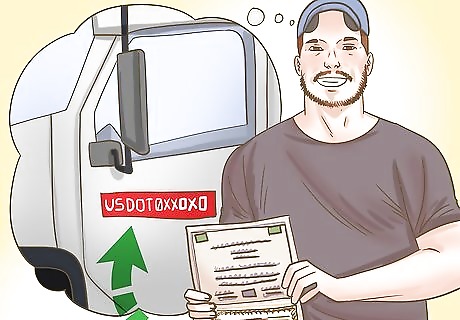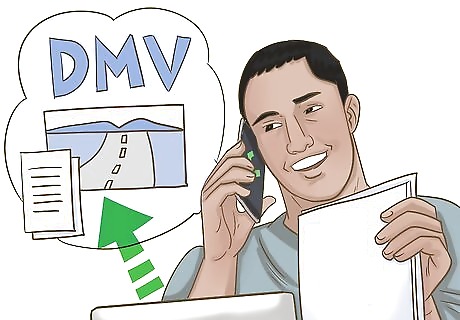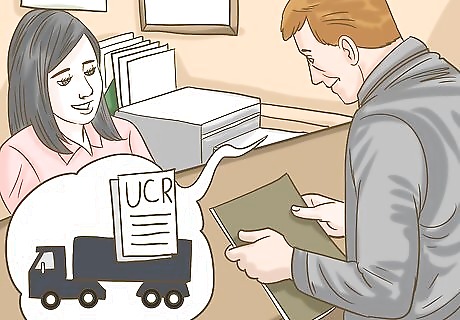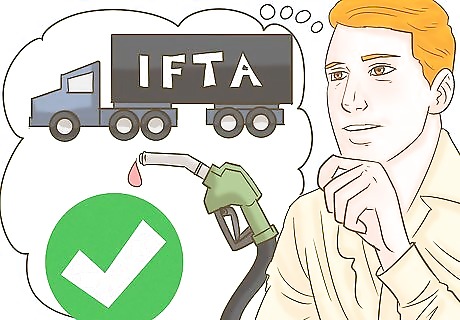
views
Registering Your Vehicle Locally

Make sure your vehicle requires commercial registration. The definition of a commercial vehicle may vary from one state, province, or jurisdiction to another. Check with your local DMV, transit authority, or other agency in charge of vehicle registrations to find out if you need to register your vehicle commercially. In Alaska, for example, a commercial vehicle is any vehicle that is registered in the name of a business or company. Your vehicle’s registration status may also depend on what you use it for (such as transporting goods or people for business purposes) and how big the vehicle is (e.g., over 8,000 lbs/3,629 kg). Your state, province, or jurisdiction may have a variety of different registration requirements depending on the nature of your vehicle. For example, a taxi must be registered differently from a limousine in New Jersey.

Apply for a USDOT number, if needed. In the US, many types of commercial vehicles need a USDOT or local DOT number before you can register and operate them. If your vehicle meets the requirements of the Federal Motor Carrier Safety Administration (FMCSA) and you plan to use it across state boundaries, you will need a USDOT number. If your vehicle will only operate within your state, you may only need a local DOT number, depending on your state’s laws. You can apply for a DOT number at the FMCSA website here: https://portal.fmcsa.dot.gov/UrsRegistrationWizard/ Check this page to determine whether you need a USDOT or local DOT number: https://www.fmcsa.dot.gov/registration/do-i-need-usdot-number

Complete a registration form. You may be able to register online through your DMV website, or you may have to go to your local DMV office and ask for the appropriate form(s). Depending on where you are registering the vehicle, the registration form may be combined with a title form. If you don’t already have a title to the vehicle, you’ll need to apply for one. Indicate on the form that you are registering a commercial vehicle, and provide any applicable information. You may need to provide information such as your DOT number (if applicable), the tax ID associated with your DOT number, and the size and type of vehicle you are registering.

Present additional documents, if needed. Check your form or ask at your DMV if any other supporting documents are needed. These may include your title, proof of identification, and insurance information. If you live in the U.S. and your vehicle weighs over 55,000 lbs (24,948 kg), you will need to fill out and attach a Heavy Highway Vehicle Use tax form (IRS form 2290).

Pay any required application fees. Check with your local DMV or tag office to find out about any fees you need to pay, and what payment methods they accept. In addition to the basic fee for registering your vehicle, you may be required to pay additional fees based on the gross weight at which you plan to operate your vehicle. For example, in Arizona, gross weight fees range between $7.50 (for a vehicle up to 8,000 lbs) and $918 (75,001-80,000 lbs).
Obtaining Unified Carrier Registration

Find out if you need to apply for Unified Carrier Registration. UCR is a federally mandated program in the U.S. You will need to register if you operate 1 or more trucks or buses that travel across state or international lines for business purposes.

Register online or fill out a registration form. To register with the UCR, you will need to fill out an application form. You can obtain a print or PDF form from your local DMV or equivalent agency, or complete the process online here: https://www.ucr.gov/ You will need to provide your USDOT number, information about your business, and information about the types and number of vehicles you will be operating.

Pay your UCR registration fee. The fee is based on how many vehicles you are operating. You can pay online through the UCR website when you register, or submit a payment by mail to your local DMV or equivalent agency. Fees range from $69 (for 0-2 vehicles) to $6,820 (for 101-1000 vehicles). If you own a fleet of more than 1000 vehicles, the fee increases drastically to $66,597.
Signing Up for the International Registration Plan

Contact your base jurisdiction about registration requirements. The International Registration Plan (IRP) is an international agreement between the U.S. states, the District of Columbia, and Canada. IRP registration is required if you want to operate a commercial vehicle across multiple states or between Canada and the U.S. Use the IRP directory to find the contact information for the IRP office in your base jurisdiction: https://www.irponline.org/search/custom.asp?id=381 In addition to filling out an application form, you may need to provide a variety of supporting documents, such as proofs of residency, relevant tax forms, proof of insurance, your DOT number, and a local business license.

Pay any necessary registration fees. Your registration fees will vary based on an array of factors, including your base jurisdiction, the distance you will be driving your vehicle, the size and age of the vehicle, any taxes that may apply to your vehicle, and so on. Check with your base jurisdiction to find out how much you must pay, and what payment methods they accept. You can estimate your registration fees using the IRP’s Celtic Fee Estimator: https://www.irponline.org/page/FeeEstimator

Check with your base jurisdiction about cross-border requirements. If you are planning to use your vehicle to travel between the U.S. and Canada for business reasons, your base jurisdiction may have additional registration requirements. Check with your local IRP office to find out what further documents or registration steps may be needed.
Completing IFTA Registration

Find out if your vehicle needs IFTA registration. The IFTA, or International Fuel Tax Agreement, governs the reporting of fuel use by carriers that operate between member jurisdictions. IFTA operates in the Canadian Provinces and all of the U.S. states except Hawaii and Alaska. You will need to register for IFTA if your vehicle operates between 2 or more participating jurisdictions and: Has 2 axles and a gross registered weight of more than 26,000 lbs (11,797 kg) Has 3 or more axles, regardless of gross weight Is used in combination with other vehicles that have a combined gross registered weight of more than 26,000 lbs (11,797 kg)

Complete your International Registration Plan application first. Most vehicles requiring IFTA registration will also require IRP registration. You will likely need to either complete your IRP application first, or submit both applications at the same time. Some jurisdictions may offer a combined application form.

Fill out an IFTA registration form in your base jurisdiction. Visit your local DMV, department of transportation, or equivalent agency to get the appropriate application form. Registration fees for IFTA membership are typically quite small (e.g., $10 in California). The nature of your vehicle ownership (e.g., individual, corporate, or as part of a general partnership) Your previous history of IFTA and IRP membership The type(s) of fuel your vehicle uses Your DOT number Your vehicle registration number

Display your IFTA decals on your vehicle. Once your IFTA application is accepted, you will receive decals to affix to any registered vehicles. Follow your jurisdiction’s instructions for where to display the decals. You will receive a license and 2 decals per registered vehicle. Decals must be properly displayed, and will need to be replaced annually when you renew your IFTA license.



















Comments
0 comment